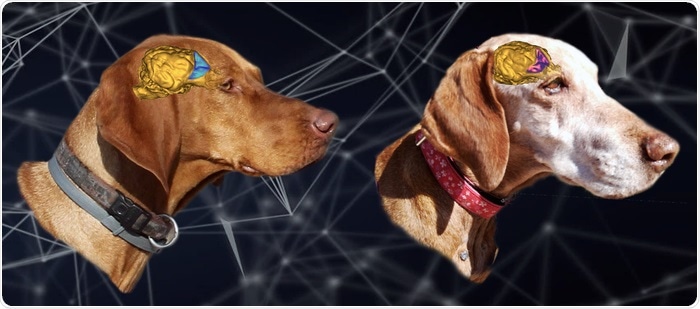Upon examining the gene activity in dog brain tissues, it was revealed that a major part—16,000 out of 20,000 genes—is active in every animal, and around 3,500 genes are differentially expressed between the age groups. Furthermore, less than a hundred genes were seen active in the old dogs particularly, rather than the young ones.

Genetic changes associated with dog aging are more about quantity than quality. Image Credit: Kalman Czeibert.
This implies that genetic alterations linked with aging are less about quality and more about quantity. The altered gene’s activity had operations in controlling other genes, neural growth, activity, and the immune system. Certain genes with essential neural purposes revealed a pattern of changes that are the same as humans but different from rodents.
In recent years, the interest in dogs as natural models of human aging has increased rapidly resulting in the formation of multi-layered research initiatives, such as the Senior Family Dog Project in Hungary, for studying the aging of dogs.
In addition, the number of preclinical studies that involve companion dogs in drug tests targeting age-associated decline or diseases with human parallels is increasing, with potential medical benefits for humans as well as canines.
Although, for these investigations to be successful in examining the drug effects, the translatability among dogs and humans needs to be guaranteed on all biological levels. The molecular mechanisms underlying the aging of the dog brain and age-associated dementia are hardly known, and they can hamper the translational studies’ efficiency.
Sequencing the RNA molecules in a biological sample is a powerful tool to explore genetic regulatory mechanisms. We used this technique to investigate the neural aging of dogs.”
Sára Sándor, Study First Author and Geneticist, Eötvös Loránd University
The study was published in GeroScience.
The research team for Hungary depended on brain samples from companion dogs donated to the Canine Brain and Tissue Bank at Eötvös Loránd University.
There were six dogs in 1–4 years old, and seven in 14–17 years old, demonstrating eight breeds and mixed breeds.
We used bioinformatic analyses to look for age-related changes in genetic mechanisms. We found that the two age groups were clearly separated based on their averaged sequencing profile.”
Jonas David, Study First Author and Bioinformatician, Eötvös Loránd University
This implied vigorous changes in the activity of genes as dogs grew old, independently from their breed. A four-year-old German shepherd dog is the only animal that could not be fit in either group. This dog—being the oldest among the young dogs and a large breed with a comparatively short expected lifetime—might characterize a middle state between the two age groups.
While analyzing individual genes, 80% of 20,000 canine genes were identified to be active in all animals.
As the total activation or inactivation of individual genes was very rare, the genetic changes associated with aging are more about quantity than quality.”
Eniko Kubinyi, Department of Ethology, Eötvös Loránd University
Eniko is the principal investigator of the Senior Family Dog Project and the “Momentum” Companion Animals Research Group.
Reduced activity in aged animals was revealed in half of the differently expressed genes, whereas the other half were more active. It can reveal that age-associated alterations in the regulation of gene expression are well-tuned and do not only occur as a consequence of genomic disintegration.
The genes with modified activity control other genes, neural growth, and the immune system. Especially, certain genes involved in neural functions revealed an alteration pattern that is as same as humans but different from rodents.
The findings of the Hungarian scientists also revealed that biobanking is a dependable source for such studies, and it can also aid in reducing the requirement for laboratory dog models in the future.
Source:
Journal reference:
Sándor, S., et al. (2022) Poly(A) RNA sequencing reveals age-related differences in the prefrontal cortex of dogs. GeroScience. https://doi.org/10.1007/s11357-022-00533-3.